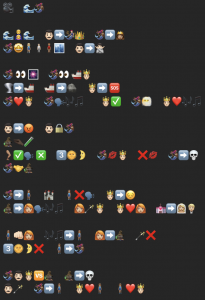
Reflection
According to Kress (2005), “words are highly conventionalised entities, and only exist in that manner” (p.15). Therefore, words are limited and nearly empty of meaning, and the meanings must be filled with readers. On the other hand, “there is an infinitely large potential of depictions — precise, specific, and full of meaning” (Kress, 2005, p.16).
Before completing this task, I thought using emoji to represent plots would be more similar to using depictions than words. However, I found a limited number of emojis to use, and most of them convey specific meanings. Therefore, emojis are more like an intersection between words and image depictions, possessing the upsides and downsides of both.
As Bolter (2001) claimed, different people may interpret the same image message in different words, and people who speak different languages may have similar picture writing. Emojis, as an intersection of words and images, might evoke mixed reactions among readers. I expect that my peers might explain my emoji task in various but similar words since most emojis express particular meanings. Moreover, due to the cultural, linguistic, and experience differences, my peers might have very different emoji writing than mine for the same story.
I relied mainly on words and ideas
After deciding on the storyline, I broke the story into its essential elements, such as characters, settings, and emotions. To ensure that my peers could follow the storyline, I focused on the most critical aspects of the story and kept emojis concise.
For concrete words, such as movie, love, and castle, I directly searched the word using the Emoji Keyboard. Words with no linked emojis pushed me to think out of the box and convey the meaning using easily recognizable emojis. For words with multiple emojis, I chose the most straightforward one to maintain clarity.
Order and position
For each chunk of my emoji story, the first symbol represents the actor of particular movements, aligning with Kress (2005)’s claim that “being first may means … being [the] cause of an action” (p.12).
I also used left-to-right and top-to-down sequencing for my emoji story, the same as my writing sequences. I believe this unconscious decision for writing order was influenced by my language (English and Mandarin), aligning with Boroditsky (2011)’s claim that languages affect people’s direction of writing. Moreover, the passage of time in my emoji story follows my writing direction. Therefore, I started with the title and completed the task following the ongoing plots.
How did I choose the theme?
Honestly, I chose the work based on how easy it would be to visualize and its popularity. I initially tried to work on Spider-Man: Across the Spider-Verse, which I watched most recently, but I couldn’t figure out a way to represent all the different versions of Spider-Man. As I mentioned before, there are limited numbers of emojis to use, restricting my ability to describe the storyline. Therefore, I chose a famous story that most people know, minimizing the possibility that my peers get confused when reading my emoji story.
References
Bolter, J. D. (2001). Writing space: Computers, hypertext, and the remediation of print (2nd ed.). Lawrence Erlbaum Associates.
Boroditsky, L. (2011). How language shapes thought. Scientific American, 304(2), 62-65.
???? Emoji Keyboard Online ???? ???? ???? ???? – Click to copy emojis. (n.d.). https://emojikeyboard.io/
Kress, G. (2005), Gains and losses: New forms of texts, knowledge, and learning. Computers and Composition, 2(1), 5-22.

